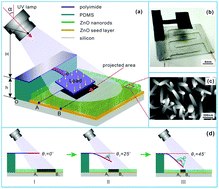High-performance optical projection controllable ZnO nanorod arrays for microweighing sensors†
Abstract
Optical microweighing sensors are an essential component of micro-force measurements in physical, chemical, and biological detection fields, although, their limited detection range (less than 15°) severely hinders their wide application. Such a limitation is mainly attributed to the essential restrictions of traditional light reflection and optical waveguide modes. Here, we report a high-performance optical microweighing sensor based on the synergistic effects of both a new optical projection mode and a ZnO nanorod array sensor. Ascribed to the unique configuration design of this sensing method, this optical microweighing sensor has a wide detection range (more than 80°) and a high sensitivity of 90 nA deg−1, which is much larger than that of conventional microcantilever-based optical microweighing sensors. Furthermore, the location of the UV light source can be adjusted within a few millimeters, meaning that the microweighing sensor does not need repetitive optical calibration. More importantly, for low height and small incident angles of the UV light source, we can obtain highly sensitive microweighing properties on account of the highly sensitive ZnO nanorod array-based UV sensor. Therefore, this kind of large detection range, non-contact, and non-destructive microweighing sensor has potential applications in air quality monitoring and chemical and biological detection.



 Please wait while we load your content...
Please wait while we load your content...